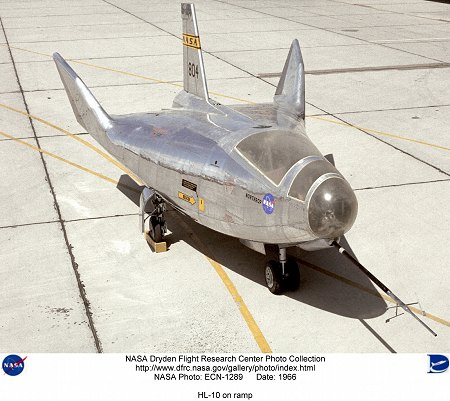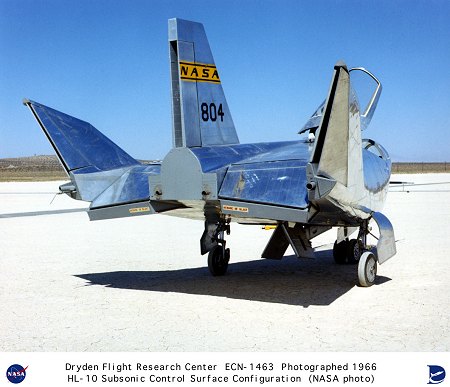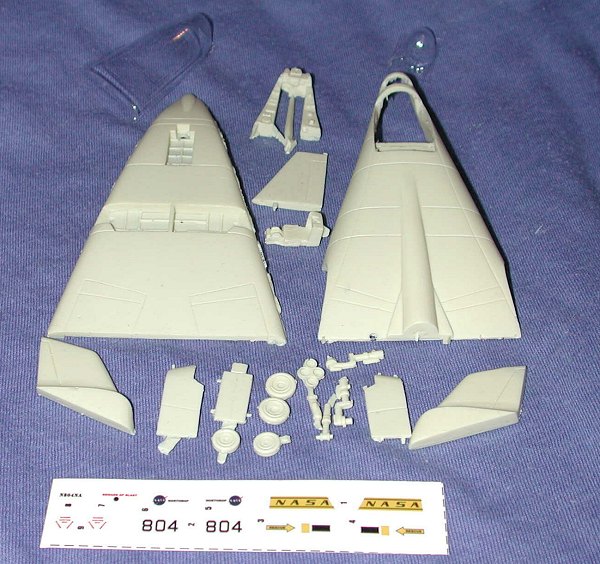
|
KIT: |
Anigrand 1/72 HL-10 Lifting Body |
|
KIT # |
AA-2014 |
|
PRICE: |
$32.50 MSRP |
|
DECALS: |
one option |
|
REVIEWER: |
Scott Van Aken |
|
NOTES: |
Resin kit |

|
HISTORY |
 The HL-10 was
one of five heavyweight lifting-body designs flown at NASA's Flight
Research Center (FRC--later Dryden Flight Research Center), Edwards,
California, from July 1966 to November 1975 to study and validate the
concept of safely maneuvering and landing a low lift-over-drag vehicle
designed for reentry from space.
The HL-10 was
one of five heavyweight lifting-body designs flown at NASA's Flight
Research Center (FRC--later Dryden Flight Research Center), Edwards,
California, from July 1966 to November 1975 to study and validate the
concept of safely maneuvering and landing a low lift-over-drag vehicle
designed for reentry from space.
Northrop Corporation built the HL-10 and M2-F2, the first two of the fleet of "heavy" lifting bodies flown by the NASA Flight Research Center. The contract for construction of the HL-10 and the M2-F2 was $1.8 million. "HL" stands for horizontal landing, and "10" refers to the tenth design studied by engineers at NASA's Langley Research Center, Hampton, Va.
After delivery to NASA in January 1966, the HL-10 made its first flight on Dec. 22, 1966, with research pilot Bruce Peterson in the cockpit. Although an XLR-11 rocket engine was installed in the vehicle, the first 11 drop flights from the B-52 launch aircraft were powerless glide flights to assess handling qualities, stability, and control. In the end, the HL-10 was judged to be the best handling of the three original heavy-weight lifting bodies (M2-F2/F3, HL-10, X-24A).
 The HL-10 was flown
37 times during the lifting body research program and logged the highest
altitude and fastest speed in the Lifting Body program. On Feb. 18, 1970,
Air Force test pilot Peter Hoag piloted the HL-10 to Mach 1.86 (1,228
mph). Nine days later, NASA pilot Bill Dana flew the vehicle to 90,030
feet, which became the highest altitude reached in the program.
The HL-10 was flown
37 times during the lifting body research program and logged the highest
altitude and fastest speed in the Lifting Body program. On Feb. 18, 1970,
Air Force test pilot Peter Hoag piloted the HL-10 to Mach 1.86 (1,228
mph). Nine days later, NASA pilot Bill Dana flew the vehicle to 90,030
feet, which became the highest altitude reached in the program.
Some new and different lessons were learned through the successful flight testing of the HL-10. These lessons, when combined with information from it's sister ship, the M2-F2/F3, provided an excellent starting point for designers of future entry vehicles, including the Space Shuttle.
Specifications
 Power:
Power:
Thanks to NASA Dryden for the photos and the historical background. It should be mentioned that the HL-10 is now proudly displayed at the entrance to NASA Dryden.
|
THE KIT |

This is what I've come to expect from a typical Anigrand kit. The detail level is quite good, consisting of nicely engraved panel lines and believable wheel well detail. There is a single set of vacuformed bits for the canopies with quite indistinct framework. Resin is used for all other parts, including the landing gear. Normally, I'd fuss about the resin gear legs, but since this is a pretty light kit compared to others, I don't think it will be much of a problem.
The fuselage is split into upper and lower halves. There is the usual amount of flash that can be easily cleaned up. There are also the usual air bubble holes, this time being mostly confined to the aft section of the upper fuselage half and the cockpit consoles. Some of these holes are also present in the intricate framework of the wheel wells, where repairing them is problematic at best. Almost all the smaller parts are free from these.
The kit can be built wheels up and the gear doors are molded in that position. Several of the small door attachment arms have been broken off during shipment so care must be taken when cutting the doors not to damage what is left. There is no mention made of nose weight, and I don't think any will be needed as the landing gear is rather well-spread apart. However, when the kit is being made, I'll definitely be making sure it isn't tail heavy! Thanks to the design of the fuselage, no worries on filling a seam running down through the interior on this one. Though no pitot tube is provided or shown in the exploded view, the HL-10 had a very prominent one that the modeler will have to make from stretched sprue.
Instructions are the usual single sheet with a history and exploded view on one side and a nice three view/painting guide on the other. The aircraft is shiny natural metal with white areas on it. Interior is listed as a mid-grey in color. Decals are provided for the lone prototype and are well printed.
Looking at the photos from the NASA website, you can see that the kit has simplified several areas, specifically the aft portion where the rudders should be separate with a large gap between them, whereas the kit has this molded as a solid piece with just a groove in that section. You'll also note that the flaps are molded in the up position as they are quite a complicated construct. As you can see from the photos, there are two different schemes, one without the large white areas and it may be that the overall bare metal only applied to the glide tests. The very back of the plane is also a painted medium grey and not shiny bare metal.
|
CONCLUSIONS |
NASA fans will want to add this kit to their collection. It is a most unusual model and probably the best one out there that isn't a vacuform. It is doubtful if you'll ever see this as a standard injected plastic kit and it will make for a most interesting addition to any collection.
|
REFERENCES |
http://www.dfrc.nasa.gov/gallery
Many thanks to DMC Models for the review kit.
UPDATE: Nostalgic Plastic is now the US Importer for Anigrand. Please contact them for more information.
If you would like your product reviewed fairly and fairly quickly by a site that has nearly 250,000 visitors a month, please contact me or see other details in the Note to Contributors.